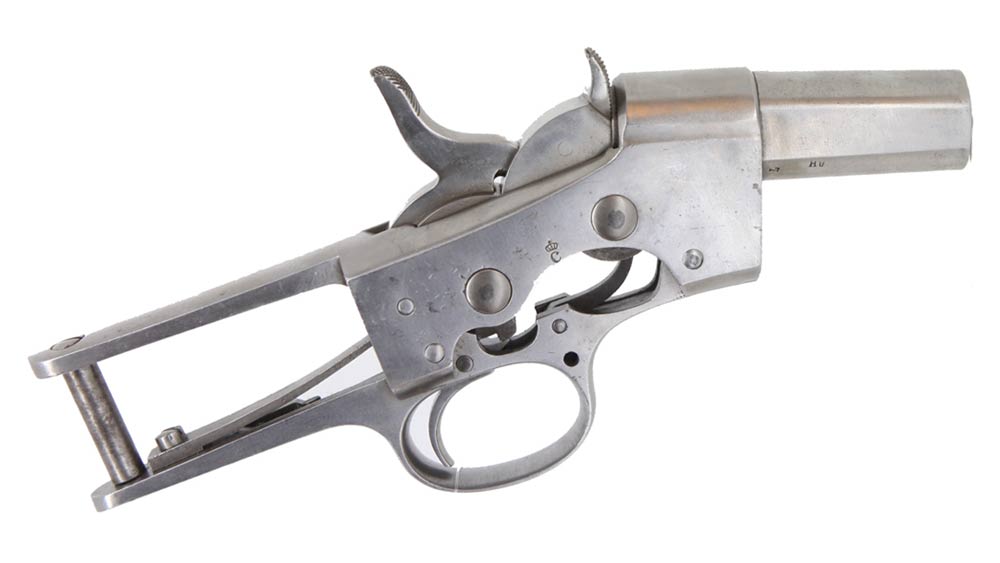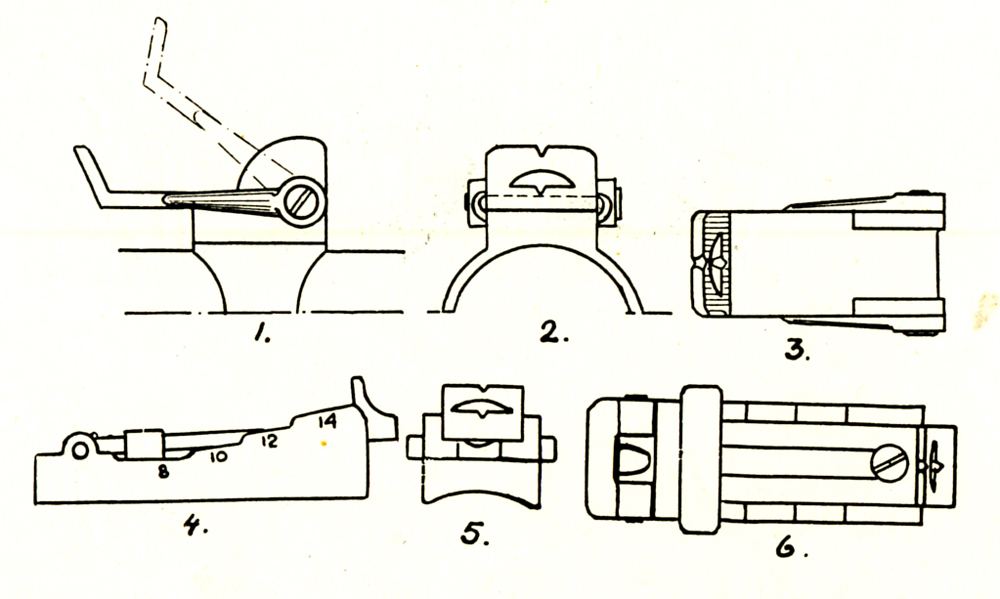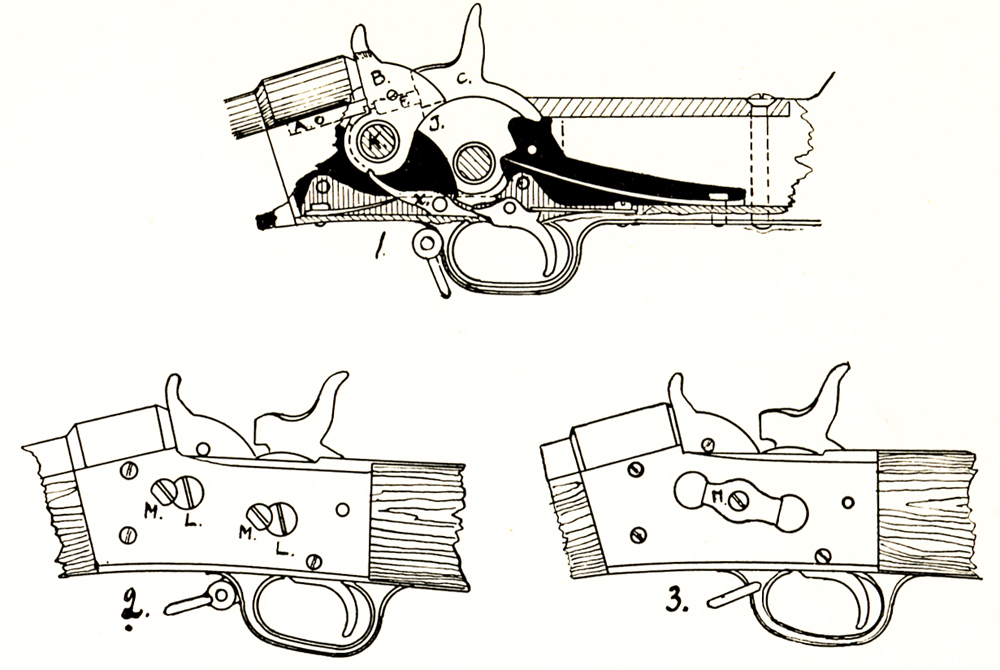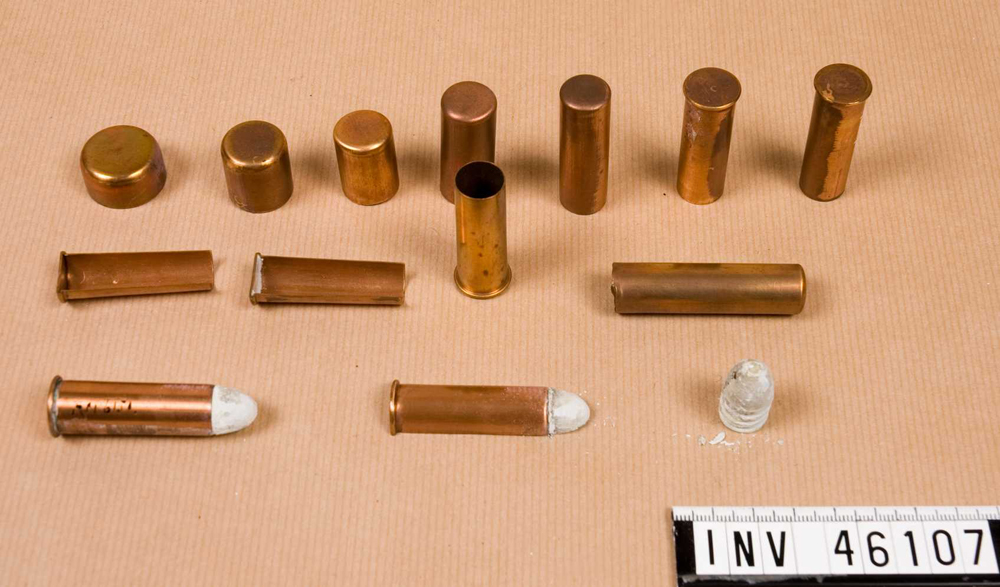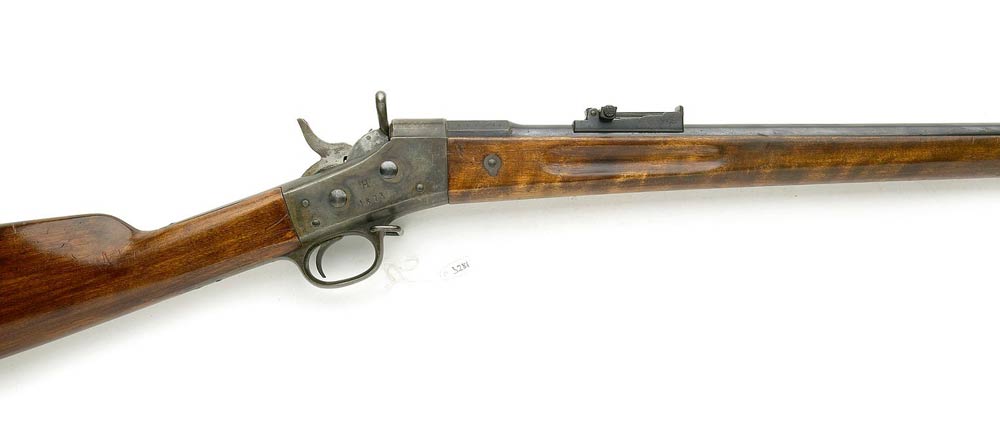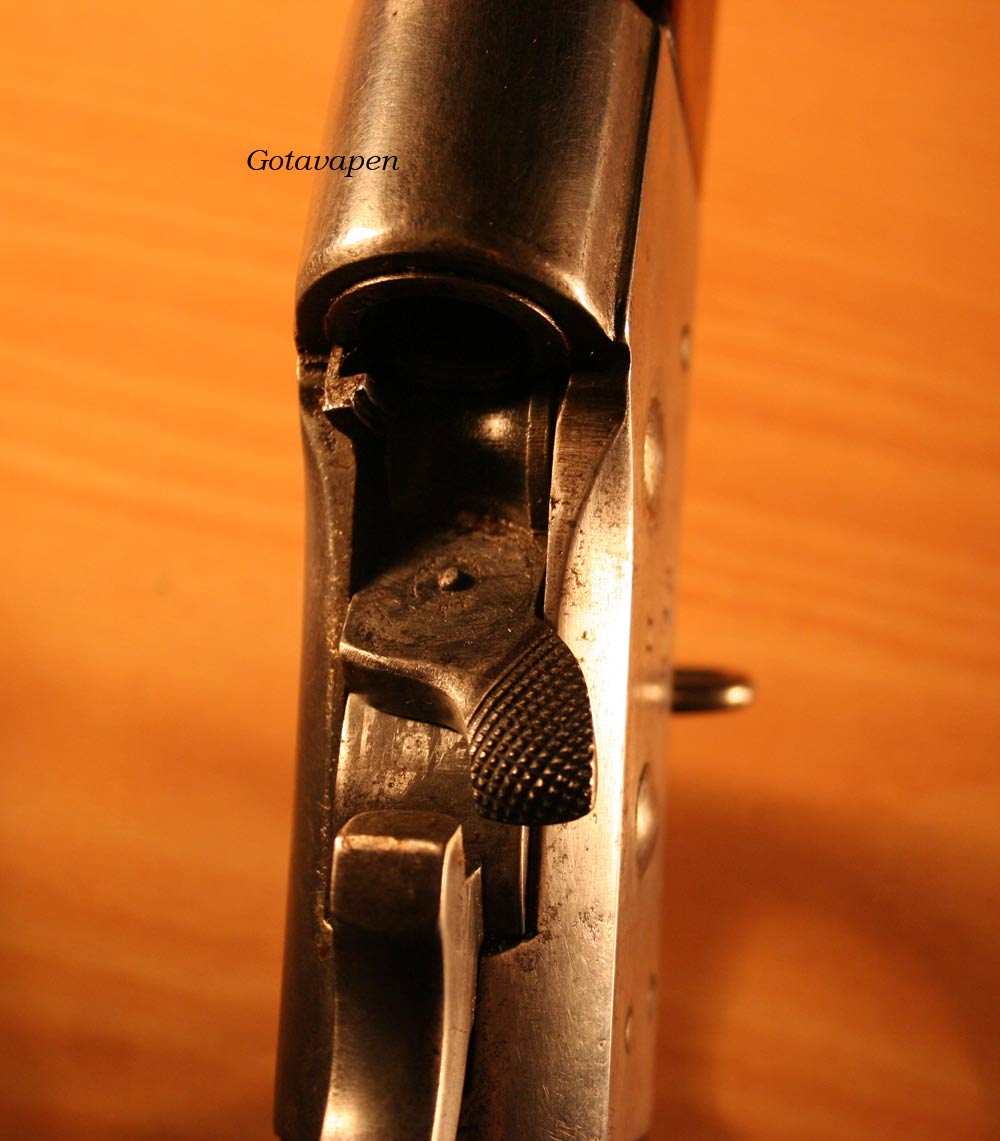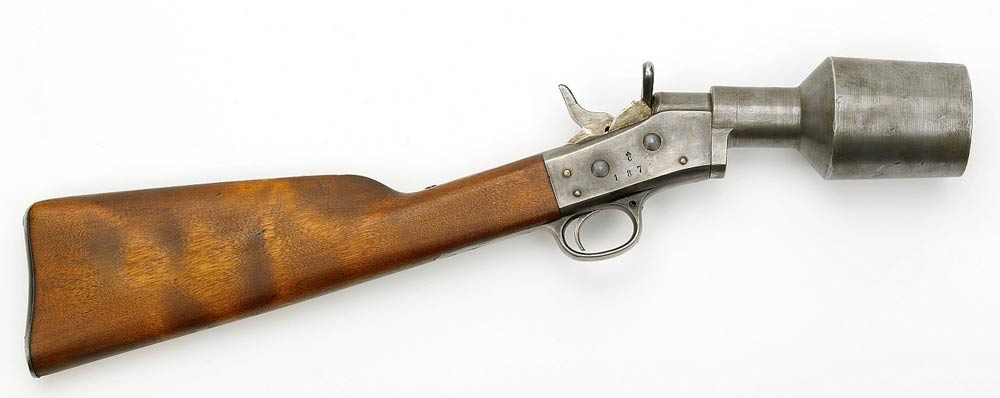The Swedish single shot rifles with mechanismbased on the Remington system.
|
BackgroundOn the 25th of October 1866 started a committee of military from Sweden and Norway to find out a suitable rifle for Sweden and Norway. Sweden and Norway were a union with the same King at this time since the Napoleon war. A number of rifles were tried. The committee found the Remington system to be the best of them. The Remington rolling block mechanism was designed and patented on the 1st of January 1863 by Joseph Rider, Newark, Ohio. Remington & Sons arms factory bought the patent and improved the construction further. It was this mechanism with patent from 1865, which was tested and accepted in Sweden. |
Bought by Sweden and Norway togetherMay 8. 1867 the Remington rifle was accepted for the Infantry in both Sweden and Norway. The cartridge was called 12.17x44RF (.50 Swedish / Norwegian) for Rim Fire cartridge. Already at that time the military realized that a caliber of 12.17 mm was inferior in ballistic sense compared to 10.5 to 11mm. However in the Swedish and Norwegian Army there were already more than 47 000 rifles. These rifles could easily be changed to the new caliber. There might also have been some influence from USA because of the change of caliber for the US rifles m 1855 from 14.7 mm (.58) to 12.7 mm (.50) by inserting a rifled tube. 1867 Sweden bought 10 000 complete rifles from Remington & Son and 20 000 complete mechanisms, together with machines for the Swedish production of Remington rifles. Tools for ammunition manufacturing were also bought from USA. The cartridge was made from copper sheet. It was 44 mm (1.73 inches) long. The bullet had three greasing rills and had a length of 22.28 mm (0.877 inches) and a diameter of 12.62 mm (0.497 inches). Bullet weight was 24 gram (372.4 grain). The black powder weight was 4.25 gram (65.9 grain) which resulted in a velocity of 386 meter per second (m/s) or 1266 Feet per Second (FpS). Around 1870 the Voluntary Shooting Association started to change their rifles to centre firing cartridges to be able to used brass bought in Germany to be able to reload at home. For official competitions they had to use original military rim fire ammunition. For this reason they often had two blocks, one with centre fire pin and one with a pin for rim fire. |
Different Rifle models.The Swedish 12.17 mm Remington type rifles are found in 8 different models. Five of new production and three of rebuild and refurbished rifles. The 5 Rifles new built Models:
The 3 Rifles from rebuilt of older type rifles. The first year of designation represents the designation of the primary rifle:
|
|
Drawings No 1, 2 and 3 shows the bow sight of m/1867 and drawings No 4, 5 and 6 shows the ramp sight for m/1868 |
|
Drawing No 1 and 2 shows the mechanism of m/1867 and m/1868 while drawing No 3 shows mechanism of m/1874 |
Rifle distributionAlready 1869 had the Army supplied the majority of the Infantry regiments with Remington rifles. Rifle m/1867 with the original type of sight was delivered to the Voluntary Shooting Association. The Infantry personal were issued with the other four models with some exceptions (see below). The Infantry of Gotland got rifle m/1860-1867. Fortress Artillery units, pioneers and sap units got m/1864-1868 Grammar schools and Universities got rifle m/1860-1864-1868.
|
Different Carbine models and their distribution:Carbine m/1870 The Royal Hussar Regiment, Jamtlands Cavalry Hunter Battalion and the Royal Horse Lifeguard got Carbines m/1870. 1880 it was decided that all cavalry units should be equipped with Carbine m/1870. 1884 this was done. Carbine m/1885 A number of the old rifles m/1864-1868 were changed to carbines according to general order from 30th of March 1885 and designated m/1864-1868-1885. These carbines were issued to Fortress units. These carbines shot the same cartridge like the rifles but because of the shorter barrel with even less velocity! Only 342 m/s or 1122 FpS.
|
New cartridge1870 the Military found the ballistic of the original 12.17x44RF cartridge to be the worst of all European cartridges. The load was too small for the huge caliber and the rifling was wrong. It was inherited from the old rifle m/1860. The rifling was acceptable when the velocity was 485 m/s (1591 FpS) but it was inferior with the velocity from the Remington (only 386 m/s or 1266 FpS).
Swedish 12.17x44RF cartridge (picture AM 46107) 1877 there was assigned a new committee of Swedish and Norwegian military personal to find a better caliber for rifles, carbines and revolvers. They recommended 10.15 mm. 1880 a General Order stated that a rifle barrel should be 10.15 mm in combination with a central firing bottled shaped cartridge, 5 gram (77.6 grain) black powder and 21.8 gram (338 grain) bullet wrapped in paper. The velocity should be 465 m/s or 1525 FpS. However nothing was decided about what type of mechanism should be used! None of the many tested mechanisms were accepted. 1889 the Army wanted to improve the rifles and have better ballistics but didn’t dare to take the full step like other European countries did - with a new magazine equipped rifle in smaller caliber. The Army was stuck in old traditions and wanted spare money. Instead the standard single shot Army rifle (Remington) was redesigned again. Only the caliber was decreased - to 8 mm. This resulted in a new but at the same time old rifle designated Rifle m/1867-1889. |
8 mm Remington m/1867-1889The firing pin was redesigned to always retract to the block and an ejector for the cartridge was equipped. Bolts for hammer and bolt were strengthened. Due to the ejector the rate of firing was increased to 6-7 shots per minute compared to 5 for m/1867. Cartridges m/1889 (8x58 mm RD) had 4.7 gram (73 grain) compressed black powder and a 30.7 gram (476,4 grain) heavy copper jacked bullet with a diameter of 8.25 mm (0.33 inches) and 57 mm long (2.24 inches) brass case in bottle shape with a rim and central firing cap. The velocity was 535 m/s or 1755 FpS.
8x58 mm (picture AM100136)
1892 the black powder was exchanged for more modern powder – “apyrit” or grey powder. This gun powder gave the bullet a velocity of 630 m/s or 2067 FpS. The Rifle m/1867-1889 was a good solid rifle with good accuracy but it soon became obsolete because it was a single shot rifle and lacked a magazine. The cavalry was the first unit which realized the advantages with more than one shot. Up until 1893 this unit was stuck with the old carbines m/1870 but 1894 they accepted the first Swedish Mauser m/1894 in caliber 6.5x55 mm.
Swedish Mauser Carbine m/1894 (6.5x55mm) |
